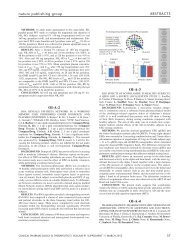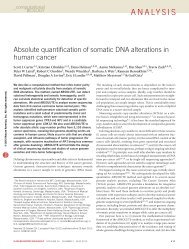open access: Nature Reviews: Key Advances in Medicine
open access: Nature Reviews: Key Advances in Medicine
open access: Nature Reviews: Key Advances in Medicine
Create successful ePaper yourself
Turn your PDF publications into a flip-book with our unique Google optimized e-Paper software.
<strong>Key</strong> advances<br />
■ Early‑onset refractory symptomatic<br />
epilepsy, frequent generalized tonic–<br />
clonic seizures, and use of antiepileptic<br />
drug (AED) polytherapy are all significant<br />
risk factors for sudden unexpected death<br />
<strong>in</strong> epilepsy 2<br />
■ A cell‑free extract from human adipose<br />
stem cells has antiseizure and<br />
antiepileptogenic effects <strong>in</strong> mice 3<br />
■ The HLA‑A*3101 allele is associated with<br />
carbamazep<strong>in</strong>e‑<strong>in</strong>duced hypersensitivity<br />
reactions among Europeans 6<br />
■ The risk of malformation <strong>in</strong> offspr<strong>in</strong>g of<br />
woman tak<strong>in</strong>g AEDs depends not only<br />
on the type of medication, but also on<br />
the AED dose and the parental history of<br />
congenital malformation 7<br />
■ Interictal high‑frequency oscillations<br />
measured with scalp electrodes can<br />
reliably del<strong>in</strong>eate the seizure‑onset zone<br />
<strong>in</strong> patients with focal epilepsy 9<br />
In a recent important publication, Tomson<br />
et al. 7 compared the relative teratogenicity<br />
of four common AEDs—carbamazep<strong>in</strong>e,<br />
pheno barbital, valproic acid and lamotrig<strong>in</strong>e—on<br />
the basis of data from the EURAP<br />
epilepsy and pregnancy registry. The authors<br />
showed that the risk of major congenital malformations<br />
<strong>in</strong>creased <strong>in</strong> a dose-dependent<br />
manner with all four assessed AEDs. Particularly<br />
high malformation rates were observed<br />
with valproic acid doses >1,500 mg per day. 7<br />
The treatment associ ated with the lowest rate<br />
of malforma tions—lamotrig<strong>in</strong>e at a dose of<br />
1,000 mg per day). Valproic acid doses of<br />








